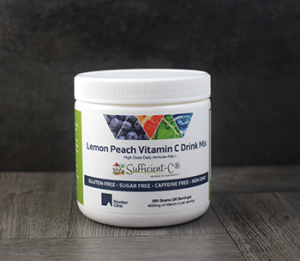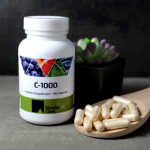Fending Off the Common Cold
By Chad Krier, N.D., D.C.
It’s that time of year again when the heating bills rise, the air dries, and we succumb to indoor activities along with everybody else, leading to an increased risk for transmission of the common cold. The more people we come in contact with and the greater the time we spend indoors the greater the risk of catching the highly contagious common cold virus.
There are many nutritional factors that play a role in both the prevention and treatment of the common cold.
The common cold is caused by infection by one of the more than 100 serotypes of rhinovirus. Unfortunately, due to the many different types and complexities of the cold virus, it is not possible to gain complete immunity to the common cold. It’s also very difficult to avoid catching a cold due to the many routes of transmission. The cold virus is transmitted in the air in aerosol form and also through saliva and nasal secretions (coughing, sneezing, sharing a drink, kissing, etc.). Once the virus is transmitted to the friendly host (you!) it begins to replicate within 8-12 hours. The virus creates symptoms anywhere from 2-5 days after hitching a ride with the host.
The most common kick backs we get for being a friendly host include: sore throat, runny nose, congestion, sneezing, and coughing. Other symptoms include pink eye, achy muscles, fatigue, headaches, and cravings for strange foods. A virus is basically like Clark Griswald’s cousin Eddie who comes uninvited for Christmas, trashes the house and overstays his welcome. Not to worry, the common cold is generally eradicated in about 7 days but can linger for 2 weeks in some cases.
Viruses not only cause pesky symptoms, but they are costly on our wallets, too. Between physician visits, over-the-counter prescriptions, prescription medicines, and missed school and work days, we spend around 32 billion dollars per year on this little nuisance. The other costly toll is the overprescribing of antibiotics for the common cold. Antibiotics should be used for bacterial infections, not for viruses. Around one-third of patients who see their doctor for the common cold are given an antibiotic. This is leading toward the current problem of antibiotic resistance.
With the cold, prevention is the key. Avoiding contact with others who have a cold would be ideal if we lived in an ideal world. However, this is practically impossible; so there are other steps we can take. Washing our hands(scrubbing with hot water) thoroughly and regularly with mild soap is a major preventative action. Avoid anti-bacterial soaps that have no effect on viruses and may be harmful to normal skin flora. Keeping your hands away from your mouth, nose, eyes, and face is also helpful. Getting adequate sleep and rest while avoiding simple sugars can give our immune system a boost. Using salt water throat gargles, herbal throat sprays, saline nasal rinses, gentle eye rinses, and cleaning under the fingernails can all help keep viruses from gaining a foothold.
There are many nutritional factors that play a role in both the prevention and treatment of the common cold.
Vitamin A supports the health of our mucous membranes that line the respiratory tract and enhances the removal of mucus. By maintaining the integrity of mucus membranes, vitamin A helps to create a protective barrier from outside invaders. Vitamin A is also an important regulator of the immune system.
Zinc promotes tissue healing and has been shown to be effective for colds when taken in the form of a zinc gluconate lozenge.
The old standby, vitamin C, promotes tissue healing and tissue integrity, enhances immune function, fights inflammation and oxidation, works as an antihistamine, and is antiviral.
Lauric acid is the main antiviral and antibacterial substance in human breast milk. It is also found in coconut.
Monolaurin is a souped up form of lauric acid that appears to be more active against viruses. Monolaurin helps prevent the attachment of viruses to susceptible host cells. Monolaurin can also inactivate viruses and inhibit their replication. Monolaurin also makes the virus stand out as more of a target for the immune system by binding to the outer envelope of the virus.
Thymic protein can also be used to give our immune system a boost. The thymus gland is where immature white blood cells go to be trained. They go in as boys and come out as men (fighting soldiers). The thymus gland is like a boot camp for the specialized white blood cells known as T-cells. As we age, the thymus gland atrophies and may not perform as well, with the result being compromise in our immune system function. Thymic protein is a chain of amino acids that can stimulate the thymus gland and turn on the T-cells. This is something I routinely take during the winter months.
There are many Botanicals that help us battle viruses and boost our immune system.
Hypericum contains constituents that inhibit encapsulated viruses.
Garlic is useful as an antimicrobial.
Baptisia contains water-soluble polysaccharides known as arabinogalactans that stimulate the immune system.
Eleutherococcus enhances activation of T-lymphocytes. It is used as a direct antiviral and in the prevention of viral illness.
Ligusticum works as an antiviral botanical and a diaphoretic (raising temperature and causing sweating). Ligusticum works great for viral sore throat infections.
Lomatium is one of the most powerful antiviral herbs around. The resin fraction of Lomatium occasionally causes a whole-body rash. The rash resolves shortly after withdrawing from the herb, but can be uncomfortable for a few days. There are preparations available that have the resin fraction removed, and these may work just as well as those with the resin fraction.
Licorice is another great antiviral herb that is supportive to the adrenal glands.
Ligustrum has strong antiviral activity and works as a powerful immune stimulant. It can raise white blood cell counts in order to battle infections.
Astragalus is another herb that increases white blood cell production while also increasing the immune fighting capabilities of natural killer cells.
Codonopsis is a great herb to use during the winter to strengthen the immune system and restore energy to the body. It is known to raise both white and red blood cell counts.
Medicinal mushrooms (Maitake, Shitake, and Reishi) contain high amounts of polysaccharides that are responsible for immune modulation. These polysaccharides increase a powerful immune chemical known as interferon which can fight off infections. Medicinal mushrooms also bolster the production of white blood cells.
A great herbal combination product for supporting the immune system and white blood cell production is called Phytoguard 2.
While the common cold presents a challenge to our immune system, there are many preventative and therapeutic tools readily available to us that can help lessen the burden of dealing with the viral invader.





